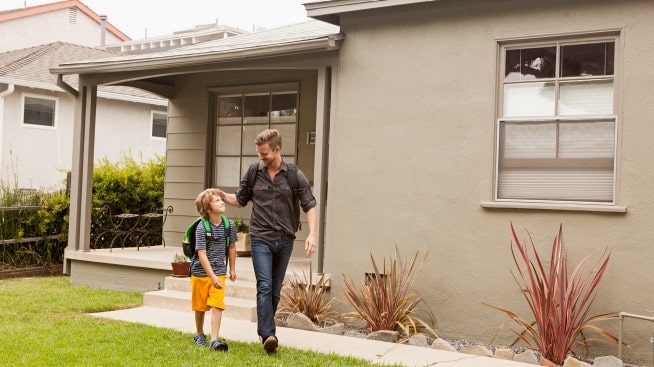5 common house styles in the U.S

When you’re on the house hunt, knowing the common house styles in the U.S. can be an informative first step in your search. As you embark on your quest, you may be curious about what kind of houses are available for your future home purchase. Here’s what to know about the different house styles so you can get a sense of what types of properties you favor or would potentially like to see yourself living in.
What are the different styles of houses?
There are many different home styles — and today you’ll likely find homes with a combination of a few of them. Although the following is by no means a comprehensive list, there are five historically noteworthy home styles that have stood the test of time:
- Colonial
- Ranch
- Contemporary
- Mediterranean
- Georgian
Colonial
With historic roots in the 1600 colonial era, it’s a classic home style in America. Originally, the homes were built by New England settlers looking for a practical, safe home for them and their families. You’ll typically find the following features in a colonial-style home:
- Rectangular shapes
- Symmetry
- High peaked roofs
- Multiple small, double-hung windows
- Materials typically vary by region, but you’ll likely come across brick or painted wooden panels with window shutters
Ranch
Ranches became popular in the mid-20th century because, at the time, they were a cost-effective build. They were commonly found in both the Midwest and Southwest where farmland was vast, inviting a build with sprawling features. Today, ranches are an enticing build because of the accessibility. You’ll typically find the following features in a ranch style home:
- One floor
- Wider windows
- Asymmetrical
- Located in warmer climates or areas with more land
Contemporary
Contemporary homes typically reflect the current time period but carry more stylistic warmth than that of a modern build. They’re often found in cities or geographically hilly areas where homes are built closer together, like Hawaii or California. You’ll typically find the following features in a contemporary style home:
- Smaller and situated on less land
- One floor to one-and-a-half floors
- Open concepts with large windows that make it look and feel larger
- Subset of modern build but designed with functionality in mind
Mediterranean
Mediterranean home styles are a mixture of Spanish and Italian architecture. Because of their red roofs and typically grandiose nature, they’re easy to identify at first glance. You’ve probably seen them in warmer climates like California, Florida or Arizona. This style became popular in the 1920s, when they represented a certain level of wealth. You’ll typically find the following features in a Mediterranean style home:
- Terracotta roofs
- Balconies
- Stucco which is a textured cement-based exterior
- Ornate archways
- Wrought iron
Georgian
Influenced by Greek and Roman architecture, Georgian style homes became popular during the reign of George I in the 1700s and are known for their intimidating symmetry and intensely hard rectangular shapes. Today, they’re often found on historic farmlands and in the New England area (and you may have also seen them on some college campuses). You’ll typically find the following features in a Georgian style home:
- Square or rectangular in shape
- Side gabled or hipped roofs the slope down like an inverted V
- Symmetrical chimneys and/or columns
- Front door located right in the middle of the house
- Two to two-and-a-half stories (A half story can be an additional bedroom or office covering part of the lower floor instead of the whole floor).
In summary
There are many unique, historically rich home styles to learn about. Colonial, ranch, contemporary, Mediterranean and Georgian styles are a few major ones to note. If you’re on the house hunt, learning about home styles can help influence what your dream home may look like down the line.



